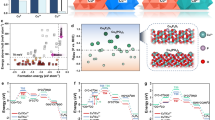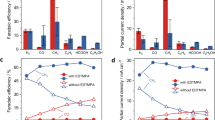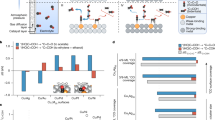Abstract
Electrochemical reduction of carbon monoxide (CO) has recently emerged as a potential approach for obtaining high-value, multicarbon products such as acetate, while the activity and selectivity for prodution of acetate have remained low. Herein, we develop an atomically ordered copper–palladium intermetallic compound (CuPd) composed of a high density of Cu–Pd pairs that feature as catalytic sites to enrich surface *CO coverage, stabilize ethenone as a key acetate path intermediate and inhibit the hydrogen evolution reaction, thus substantially promoting acetate formation. The CuPd electrocatalyst enables a high Faradaic efficiency of 70 ± 5% for CO-to-acetate electroreduction and a high acetate partial current density of 425 mA cm−2. Under membrane electrode assembly conditions, the CuPd electrocatalyst demonstrated a 500 h CO-to-acetate conversion at 500 mA cm−2 with a stable acetate Faradaic efficiency of ~50%.

This is a preview of subscription content, access via your institution
Access options
Access Nature and 54 other Nature Portfolio journals
Get Nature+, our best-value online-access subscription
$29.99 / 30 days
cancel any time
Subscribe to this journal
Receive 12 digital issues and online access to articles
$119.00 per year
only $9.92 per issue
Buy this article
- Purchase on Springer Link
- Instant access to full article PDF
Prices may be subject to local taxes which are calculated during checkout




Similar content being viewed by others
Data availability
The atomic coordinates of the optimized computational models are provided as Supplementary Data 1 with this paper. The source data of XRD (Fig. 1a) and the electrochemical stability plot (Fig. 3f) are provided with this paper. Other data that support the findings of this study are available from the corresponding author upon request.
References
Global Acetic Acid Market to Reach 24.51 Million Tons by 2025 (Expert Market Research, 2020).
Dimian, A. C. & Kiss, A. A. Novel energy efficient process for acetic acid production by methanol carbonylation. Chem. Eng. Res. Des. https://doi.org/10.1016/j.cherd.2020.04.013 (2020).
Jones, J. H. The CativaTM process for the manufacture of acetic acid: iridium catalyst improves productivity in an established industrial process. Platin. Met. Rev. 44, 94 (2000).
Jouny, M., Hutchings, G. S. & Jiao, F. Carbon monoxide electroreduction as an emerging platform for carbon utilization. Nat. Catal. 2, 1062–1070 (2019).
Ripatti, D. S., Veltman, T. R. & Kanan, M. W. Carbon monoxide gas diffusion electrolysis that produces concentrated C2 products with high single-pass conversion. Joule 3, 240–256 (2019).
Wang, L. et al. Electrochemically converting carbon monoxide to liquid fuels by directing selectivity with electrode surface area. Nat. Catal. 2, 702–708 (2019).
Feng, X., Jiang, K., Fan, S. & Kanan, M. W. A direct grain-boundary-activity correlation for CO electroreduction on Cu nanoparticles. ACS Cent. Sci. 2, 169–174 (2016).
Ni, F. et al. N-modulated Cu+ for efficient electrochemical carbon monoxide reduction to acetate. Sci. China Mater. 63, 2606–2612 (2020).
Yang, P. et al. Overcoming immiscibility toward bimetallic catalyst library. Sci. Adv. 6, eaaz6844 (2020).
Zhu, P. et al. Direct and continuous generation of pure acetic acid solutions via electrocatalytic carbon monoxide reduction. Proc. Natl Acad. Sci. USA 118, e2010868118 (2021).
Luc, W. et al. Two-dimensional copper nanosheets for electrochemical reduction of carbon monoxide to acetate. Nat. Catal. 2, 423–430 (2019).
Jouny, M., Luc, W. & Jiao, F. General techno-economic analysis of CO2 electrolysis systems. Ind. Eng. Chem. Res. 57, 2165–2177 (2018).
Li, C. W., Ciston, J. & Kanan, M. W. Electroreduction of carbon monoxide to liquid fuel on oxide-derived nanocrystalline copper. Nature 508, 504–507 (2014).
Jouny, M. et al. Formation of carbon-nitrogen bonds in carbon monoxide electrolysis. Nat. Chem. 11, 846–851 (2019).
Norskov, J. K., Bligaard, T., Rossmeisl, J. & Christensen, C. H. Towards the computational design of solid catalysts. Nat. Chem. 1, 37–46 (2009).
Ma, S. et al. Electroreduction of carbon dioxide to hydrocarbons using bimetallic Cu-Pd catalysts with different mixing patterns. J. Am. Chem. Soc. 139, 47–50 (2017).
Yamauchi, M. & Tsukuda, T. Production of an ordered (B2) CuPd nanoalloy by low-temperature annealing under hydrogen atmosphere. Dalton Trans. 40, 4842–4845 (2011).
Fei, H. et al. Atomic cobalt on nitrogen-doped graphene for hydrogen generation. Nat. Commun. 6, 8668 (2015).
Filez, M., Redekop, E. A., Poelman, H., Galvita, V. V. & Marin, G. B. Advanced elemental characterization during Pt-In catalyst formation by wavelet transformed X-ray absorption spectroscopy. Anal. Chem. 87, 3520–3526 (2015).
Li, J. et al. Constraining CO coverage on copper promotes high-efficiency ethylene electroproduction. Nat. Catal. 2, 1124–1131 (2019).
Hanselman, S., Koper, M. T. M. & Calle-Vallejo, F. Computational comparison of late transition metal (100) surfaces for the electrocatalytic reduction of CO to C2 Species. ACS Energy Lett. 3, 1062–1067 (2018).
Yang, N. et al. Synthesis of ultrathin PdCu alloy nanosheets used as a highly efficient electrocatalyst for formic acid oxidation. Adv. Mater. 29, 1700769 (2017).
Fan, J. et al. Synthesis of ultrathin wrinkle-free PdCu alloy nanosheets for modulating d-band electrons for efficient methanol oxidation. J. Mater. Chem. A 6, 8531–8536 (2018).
Jouny, M., Luc, W. & Jiao, F. High-rate electroreduction of carbon monoxide to multi-carbon products. Nat. Catal. 1, 748–755 (2018).
Yang, X., Fugate, E. A., Mueanngern, Y. & Bakeret, L. R. Photoelectrochemical CO2 reduction to acetate on iron−copper oxide catalysts. ACS Catal. 7, 177–180 (2017).
Raciti, D. et al. Low-overpotential electroreduction of carbon monoxide using copper nanowires. ACS Catal. 7, 4467–4472 (2017).
Wang, Y. et al. Catalyst synthesis under CO2 electroreduction favours faceting and promotes renewable fuels electrosynthesis. Nat. Catal. 3, 98–106 (2019).
Stephan, A. K. Standardized battery reporting guidelines. Joule 5, 1–2 (2021).
Wen, Y.-N. & Zhang, J.-M. Surface energy calculation of the fcc metals by using the MAEAM. Solid State Commun. 144, 163–167 (2007).
Mittendorfer, F., Seriani, N., Dubay, O. & Kresse, G. Morphology of mesoscopic Rh and Pd nanoparticles under oxidizing conditions. Phys. Rev. B 76, 233413 (2007).
Lum, Y., Cheng, T., Goddard, W. A. 3rd & Ager, J. W. Electrochemical CO reduction builds solvent water into oxygenate products. J. Am. Chem. Soc. 140, 9337–9340 (2018).
Cheng, T., Xiao, H. & Goddard, W. A. 3rd Full atomistic reaction mechanism with kinetics for CO reduction on Cu(100) from ab initio molecular dynamics free-energy calculations at 298 K. Proc. Natl Acad. Sci. USA 114, 1795–1800 (2017).
Cheng, T., Xiao, H. & Goddard, W. A. Nature of the active sites for CO reduction on copper nanoparticles; suggestions for optimizing performance. J. Am. Chem. Soc. 139, 11642–11645 (2017).
Bligaard, T. et al. The Brønsted–Evans–Polanyi relation and the volcano curve in heterogeneous catalysis. J. Catal. 224, 206–217 (2004).
Wang, S. et al. Universal transition state scaling relations for (de)hydrogenation over transition metals. Phys. Chem. Chem. Phys. 13, 20760–20765 (2011).
Gunathunge, C. M. et al. Spectroscopic observation of reversible surface reconstruction of copper electrodes under CO2 reduction. J. Phys. Chem. C 121, 12337–12344 (2017).
Salimon, J., Hernández-Romero, R. M. & Kalaji, M. The dynamics of the conversion of linear to bridge CO on Cu. J. Electroanal. Chem. 538–539, 99–108 (2002).
Chou, T. C. et al. Controlling the oxidation state of the Cu electrode and reaction intermediates for electrochemical CO2 reduction to ethylene. J. Am. Chem. Soc. 142, 2857–2867 (2020).
Jiang, T.-W. et al. Spectrometric study of electrochemical CO2 reduction on Pd and Pd-B electrodes. ACS Catal. 11, 840–848 (2021).
Kruppe, C. M., Krooswyk, J. D. & Trenary, M. Polarization-dependent infrared spectroscopy of adsorbed carbon monoxide to probe the surface of a Pd/Cu(111) single-atom alloy. J. Phys. Chem. C 121, 9361–9369 (2017).
Farias, M. J. S., Busó-Rogero, C., Gisbert, R., Herrero, E. & Feliu, J. M. Influence of the CO adsorption environment on its reactivity with (111) terrace sites in stepped Pt electrodes under alkaline media. J. Phys. Chem. C.118, 1925–1934 (2014).
Gillespie, D. T. Stochastic simulation of chemical kinetics. Annu. Rev. Phys. Chem. 58, 35–55 (2007).
Chen, Z. et al. Beyond mean-field microkinetics: toward accurate and efficient theoretical modeling in heterogeneous catalysis. ACS Catal. 8, 5816–5826 (2018).
Luc, W., Rosen, J. & Jiao, F. An Ir-based anode for a practical CO2 electrolyzer. Catal. Today 288, 79–84 (2017).
Yang, Y. et al. Infrared spectroelectrochemical study of dissociation and oxidation of methanol at a palladium electrode in alkaline solution. Langmuir 29, 1709–1716 (2013).
Kresse, G. & Hafner, J. Ab initio molecular dynamics for open-shell transition metals. Phys. Rev. B 48, 13115–13118 (1993).
Kresse, G. & Furthmüller, J. Efficiency of ab initio total energy calculations for metals and semiconductors using a plane-wave basis set. Comput. Mater. Sci. 6, 15–50 (1996).
Kresse, G. & Furthmüller, J. Efficient iterative schemes for ab initio total-energy calculations using a plane-wave basis set. Phys. Rev. B 54, 11169–11186 (1996).
Blochl, P. E. Projector augmented-wave method. Phys. Rev. B 50, 17953–17979 (1994).
Monkhorst, H. J. & Pack, J. D. Special points for Brillouin-zone integrations. Phys. Rev. B 13, 5188–5192 (1976).
Perdew, J. P., Burke, K. & Ernzerhof, M. Generalized gradient approximation made simple. Phys. Rev. Lett. 77, 3865–3868 (1996).
Mason, S. E., Grinberg, I. & Rappe, A. M. First-principles extrapolation method for accurate CO adsorption energies on metal surfaces. Phys. Rev. B 69, 161401 (2004).
Nørskov, J. K. et al. Origin of the overpotential for oxygen reduction at a fuel-cell cathode. J. Phys. Chem. B 108, 17886–17892 (2004).
Peterson, A. A., Abild-Pedersen, F., Studt, F., Rossmeisl, J. & Nørskov, J. K. How copper catalyzes the electroreduction of carbon dioxide into hydrocarbon fuels. Energy Environ. Sci. 3, 1311–1315 (2010).
Calle-Vallejo, F. & Koper, M. T. M. First-principles computational electrochemistry: achievements and challenges. Electrochim. Acta 84, 3–11 (2012).
Acknowledgements
We thank the following funding agencies for supporting this work: the National Key Research and Development Programme of China (nos. 2018YFA0209401 to G.Z. and 2018YFA0208600 to X.X.); the Natural Science Foundation of China (nos. 22025502 and 21975051 to G.Z. and 21688102 to X.X.); the Science and Technology Commission of Shanghai Municipality (nos. 21DZ1206800 and 19XD1420400 to G.Z.); and the Shanghai Municipal Education Commission (no. 2019-01-07-00-07-E00045 to G.Z.). This research used the synchrotron resources of Canadian Light Source.
Author information
Authors and Affiliations
Contributions
G.Z. and X.X. proposed, designed and supervised the project. G.Z., X.X., Y.J., Z.C. and Y.W. wrote the manuscript. Y.J. synthesized catalysts and performed electrochemistry experiments. Y.J., C.Y. and A.G. analysed electrochemical data. Z.C. and X.X. performed theoretical calculations. R.W. and Y.Y. conducted ATR–SEIRAS measurements. J.X., H.Z. and J.L. performed aberration-corrected HAADF–STEM characterizations. J.C. and T.-K.S. performed X-ray absorption spectroscopy characterizations. All authors contributed to discussion of the results and manuscript preparation.
Corresponding authors
Ethics declarations
Competing interests
The authors declare no competing interests.
Peer review
Peer review information
Nature Catalysis thanks Yijin Kang and the other, anonymous, reviewer(s) for their contribution to the peer review of this work.
Additional information
Publisher’s note Springer Nature remains neutral with regard to jurisdictional claims in published maps and institutional affiliations.
Supplementary information
Supplementary Information
Supplementary methods, Figs. 1–46, Tables 1–21 and references.
Supplementary Data
A compressed zip file containing all optimized DFT structures (in Vienna ab initio simulation package CONTCAR format).
Source data
Source Data Fig. 1
Source data of XRD for CuPd (Fig. 1a).
Source Data Fig. 3
Source data of the stability plot (Fig. 3f).
Rights and permissions
About this article
Cite this article
Ji, Y., Chen, Z., Wei, R. et al. Selective CO-to-acetate electroreduction via intermediate adsorption tuning on ordered Cu–Pd sites. Nat Catal 5, 251–258 (2022). https://doi.org/10.1038/s41929-022-00757-8
Received:
Accepted:
Published:
Issue Date:
DOI: https://doi.org/10.1038/s41929-022-00757-8
This article is cited by
-
General synthesis and atomic arrangement identification of ordered Bi–Pd intermetallics with tunable electrocatalytic CO2 reduction selectivity
Nature Communications (2024)
-
Ligand-modified nanoparticle surfaces influence CO electroreduction selectivity
Nature Communications (2024)
-
Tandem reactors and reactions for CO2 conversion
Nature Chemical Engineering (2024)
-
Site-selective protonation enables efficient carbon monoxide electroreduction to acetate
Nature Communications (2024)
-
Efficient electrosynthesis of formamide from carbon monoxide and nitrite on a Ru-dispersed Cu nanocluster catalyst
Nature Communications (2023)



